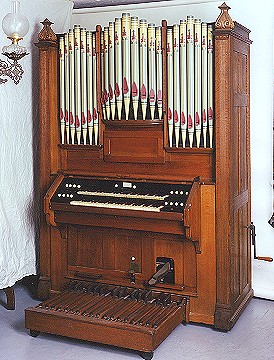
Behind the pipe facade (see Pipe Facade picture below) are the swell shades
and behind the swell shades (see Swell Shades picture below) are individual chests that contain
their corresponding sets of reeds. The chests are connected between two large wind trunks
that run vertically. Each chest is complete and separate of other chests,
which gives each set of reeds its own soundboard.
The end result is a very powerful sound unequalled.
An inherent fault of conventional reed organs with more than one set of reeds is the fact
that they all share the same soundboard and consequently one set of reeds will
"influence" the sound of another set of reeds.
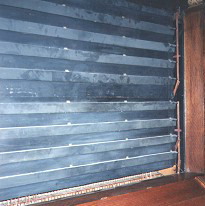 |
The Phonorium reeds all have
individual cells and a valve per each reed. The valve is located on the
outside of the reed cell so the vacuum works with the valve. A system
of rods opens the valves, from the end of the keys, on the swell
manual. The great has a vacuum assist (see Vacuum Assist picture below)
which activates the rods.
|
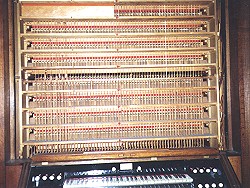 |
The Phonorium reeds all have individual cells and a valve per each reed.
The valve is located on the outside of the reed cell so the vacuum works with the valve.
A system of rods opens the valves, from the end of the keys, on the swell manual.
The great has a vacuum assist (see below) which activates the rods.
The entire system requires two levels of vacuum, a low level to supply the reeds
and a high level for the vacuum assist, a chest which contains large pouches when activated,
provide the power to push the rods.
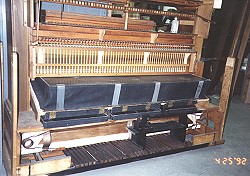
In the photo above you can see the
main low level reservoir on the bottom,
this is the full width of the organ. Directly above are the hinge ends
of the six feeders,
three supply the low level side and three provide the high level side.
Above the feeders is the high level reservoir which contains ten 12#
springs;
it is reinforced with automotive seat belt straps. The original plywood
had literally
been pushed apart from the spring tension. Above the reservoir is the
vacuum assist chest
with the cover removed showing the primary valves.
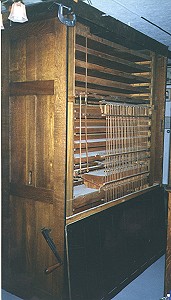
Here is a shot (above) looking in
the back showing the
individual chests and the pedal coupler mechanism.
| Great 16 Bourdon 8 Diapason 8 Trumpet 4 Octave Pedal 16 Stopped Diapason 16 Open Diapason |
Swell 8 Oboe 8 Dulciana 8 Gamba 8 Choral 4 Flute 2 Harp Aeolienne Tremolo |
| Couplers Sw to Gt Sw to Ped Gt to Ped Octave Coupler (Gt) |
Accessories Great Forte Bellows Signal Wind Indicator Balanced Swell Pedal Full Organ Pedal |
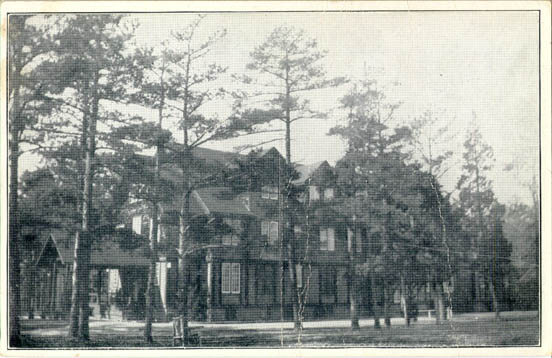
The organ was found in the Seton Inn, Lakewood, NJ, by Denise Novickij.
The building was about to be torn down, and we are indebted to MS Novickij
for having the curiosity and vision to save this important instrument!
Phonorium Moving Photos
Sources
Out-Back Mechanical Music
David Smith
Denise Novickij
Back